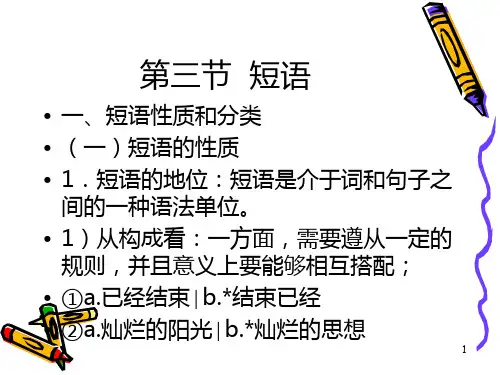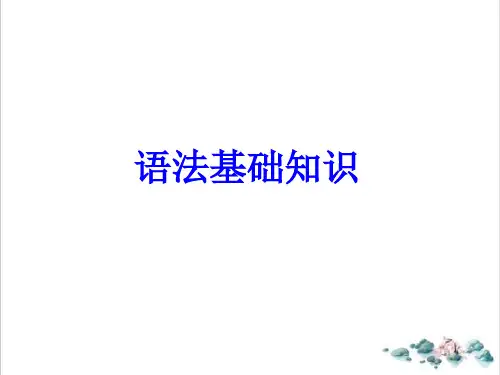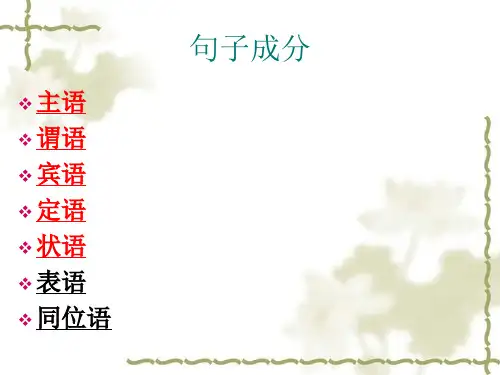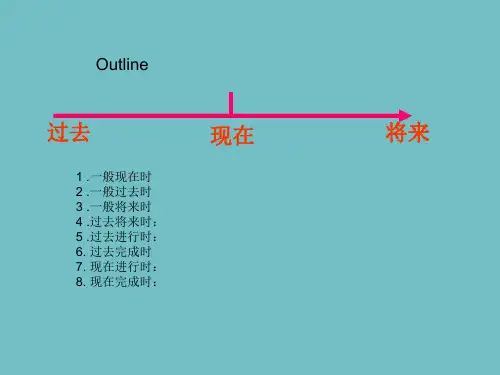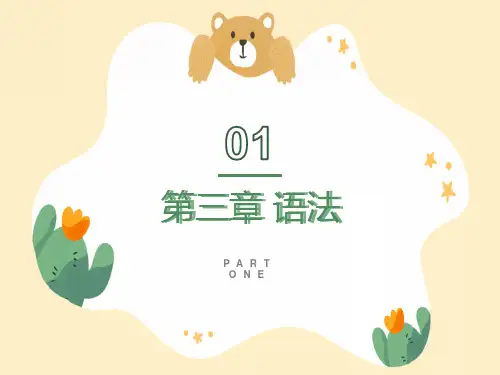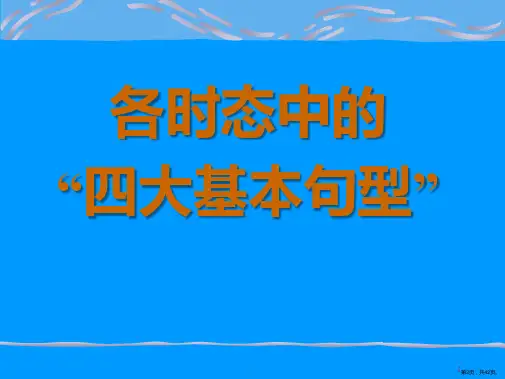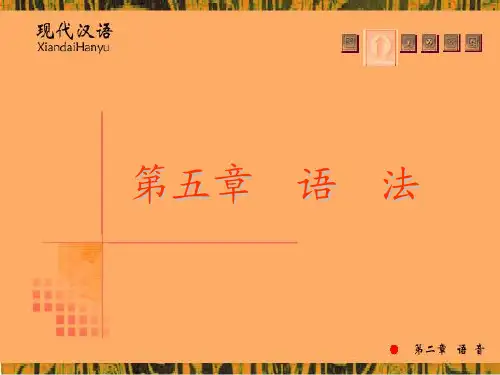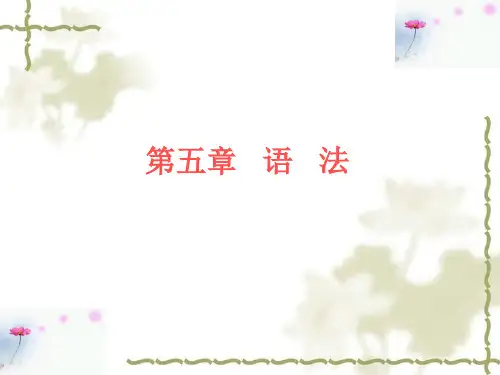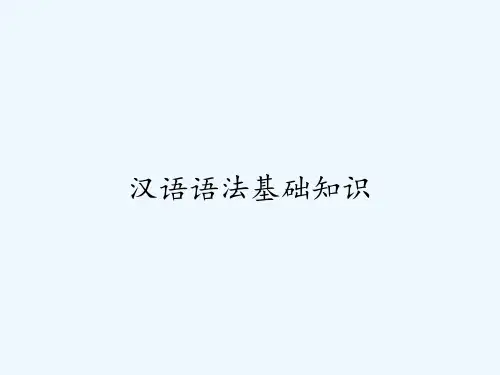- 1、下载文档前请自行甄别文档内容的完整性,平台不提供额外的编辑、内容补充、找答案等附加服务。
- 2、"仅部分预览"的文档,不可在线预览部分如存在完整性等问题,可反馈申请退款(可完整预览的文档不适用该条件!)。
- 3、如文档侵犯您的权益,请联系客服反馈,我们会尽快为您处理(人工客服工作时间:9:00-18:30)。
注:在实际应用时,现在进行时常用于以下几种情况: ①当句子中有now时,常表示动作正在进行,这时要用现 在进行时。 如:They are playing basketball now.现在他们正在打篮球。 ②以look, listen开头的句子,提示我们动作正进行,这时 要用现在进行时。 如:Listen!She is singing an English song.听,她正在唱英 语歌。 ③表示当前一段时间或现阶段正在进行的动作,且此时有 this week, these days等时间状语,这时常用现在进行时。 如:We are making model planes these days.这些天我们在做 飞机模型。 ④描述图片中的人物的动作,也为了表达更生动。此时也 常用现在进行时。 如:Look at the picture. The children are flying kites in the park.看这幅图,那些孩子正在公园放风筝。
7.时间表和日程安排 The plane leaves at 4 p.m. 飞机下午四点起飞。 When do courses begin this semester? 这学期课程 什么时候开始? ※ 通常和一般现在时搭配的词有:usually, always, often, sometimes, on Saturdays, at weekends (美式英语说 on weekends), rarely, on occasion, never, seldom
2. 表示感觉的动词 see看见,hear听见,find发现,notice注意到, feel觉得等。 3. 表示状态的动词 be是,have有,belong属于,own拥有, possess拥有,suit适合,fit适合,contain包含, depend依靠,smell有……的气味 ,taste 有……的味道,seem显得,look显得,appear 看来,turn out变成,等。
2.另外,现在进行时还可表示将来,主要用于表示按 计划或安排要发生的动作。 如: I‘m leaving tomorrow. 我明天走。 They’re getting married next month. 他们下个月结婚。 Are you meeting Bill this evening? 你今晚将和比尔见面 吗?
现在进行时表示将来意义
1.现在进行时主要表示现在或目前正在进行的动作: We're having a meeting. 我们在开会。 My head is aching. 我头很疼。 Where is she teaching? 她在哪儿教书? She's spending the summer at the seaside. 她在海边度 暑假。
5. 表示渐变的动词有:get, grow, become, turn, run, go, begin等。 e.g.The leaves are turning red. e.g.It's getting warmer and warmer. 6.与always, constantly, forever 等词连用,表示反 复发生的动作或持续存在的状态,往往带有说话 人的主观色彩。 e.g.You are always changing your mind.
【比较】1. Now I put the sugar in the cup. 2. I am doing my homework now. 第一句用一般现在时,用于操作演示或指导说明 的示范性动作,表示言行的瞬间动作。再如: Now watch me, I switch on the current and stand back. 第二句中的now是进行时的标志,表示正在进行的 动作的客观状况,所以后句用一般现在时。
4.有些动词(状态动词不用于进行时态) (1)表示知道或了解的动 词:believe,doubt,forget,imagine,know, remember,realize,suppose,understand (2)表示“看起来”“看上去"appear,resemble,seem (3)表示喜爱或不喜爱hate,like.lover.prefer (4)表示构成或来源的动词 be come from.contain,include (5)表示感官的动词 hear see smell sound taste (6)表示拥有的动词belong to.need.own .possess.want wish
3) 表示格言或警句中。 Pride goes before a fall. 骄者必败。 注:此用法如果出现在宾语从句中,即使主句是过 去时,从句谓语也要用一般现在时。 例:Columbus proved that the earth is round. 4) 现在时刻的状态、能力、性格、个性。 I don't want so much. Ann Wang writes good English but does not speak well.
当主语不是第三人称单数时: 肯定句:主语+动词原形+其他 否定句:主语+don‘t+动词原形+其他 一般疑问句:Do+主语+动词原形+其他
一般现在时的用法
1) 经常性或习惯性的动作,常与表示频度的时间状语连 用。 时间状语: every…, sometimes, at….etc. I leave home for school at 7 every morning. 2) 客观真理,客观存在,科学事实。 e.g.The earth moves around the sun. e.g.Shanghai lies in the east of China.
※ 这类用法限于表示“移动”的动词:go去,come 来,leave离开,start出发,begin开始,arrive到达, take off起飞,等。
2.有些动词,即使表示现在的动作也不能用现在进行时, 也只能用一般现在时: e.g.To tell you the truth, I hate to do it. 说实话,我讨厌那样做。 e.g.I hope the weather would be fine. 我希望天气会晴朗。 e.g.I am looking into the room, and I see a strange man in it. 我朝房间里看,看到了房间里一个陌生的男子。
现在完成时 (the Present Perfect Tense )
现在完成时的构成
肯定句:主语+have / has + 过去分词 否定句:主语+have/has not+过去分词 疑问句:Have/has+主语+过去分词
英语中哪些词常与现在完成时连用
1.since 不管since 是用作介词、连词还是副词,它通常都与现 在完成时连用。 如:Great changes have taken place here since 1978. 自 1978年以来这里发生了巨大的变化。(since为介词) Her reading has improved greatly since she changed schools. 自从她转校以来,她的阅读水平提高了很多。 (since为连词) She moved to London last May and has since got a job on a newspaper. 她去年五月到伦敦,此后一直在报社工作。 (since为副词)
这类不能用于现在进行时表示正在发生动作的 动词有: 1. 表示心理状态的动词 know知道,realize意识到,think (that)认为, suppose (that)料想,doubt怀疑,forget忘记, remember记得,understand明白,regard看待, love爱,like喜欢,prefer偏好,hate讨厌,hope 希望,want想要,need需要,wish愿望,等。
能这样用的动词不多,常用的有:arrive, come, do, get, go, have, leave, meet, play, return, see, spend, start, stay, wear, work 等。
※ 我们除可用现在进行时表将来外,还可用一般现 在时表将来,两者的区别是:用现在进行时表示将来, 其计划性较强,并往往暗示一种意图;而一般现在时 表示将来,则其客观性较强,即通常被视为客观事实, 多指按时刻表或规定要发生的情况。 比较:I'm not going out this evening. 今晚我不准备出去。 What time does the train leave? 火车什么时候开? 如果主语是train, concert, programme等表示事物的名词, 动词通常一般现在时表将来,而不用进行时。如: What time does the train leave? 火车什么时候开? The program begins at 4. 这个节目四点开始。
现在进行时பைடு நூலகம்定义
现在进行时表示现在或当前一般时间正在进行的动 作。 可以表示有计划的未来。 现在分词变化规则 1.直接+ ing 2.去e+ing 3.重读闭音节,且末尾只有1个辅音字母,双写辅音 字母+ing 4.特殊变化:die-dying,lie-lying,tie-tying.etc. 5.不规则变化
一般现在时 (the Simple Present Tense)
一般现在时的构成
当主语是第三人称单数时: 肯定句:主语+动词的第三人称单数+其他 否定句:主语+doesn‘t+动词原形+其他 一般疑问句:Does+主语+动词原形+其他 肯定回答:Yes,主语+does;否定回答:No,主语+doesn’t 特殊疑问句:特殊疑问词+一般疑问句
